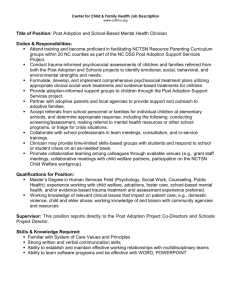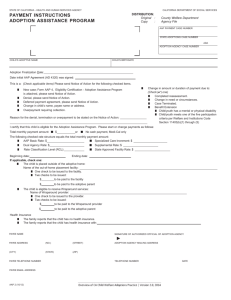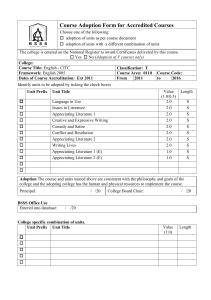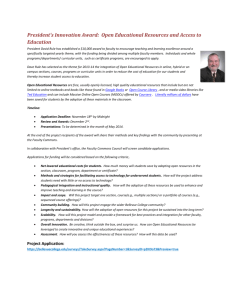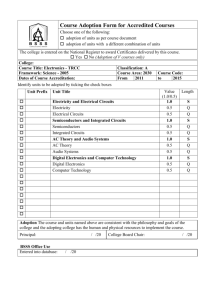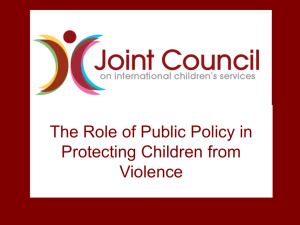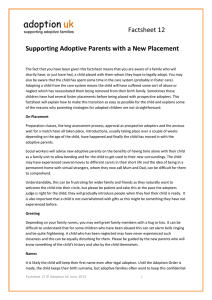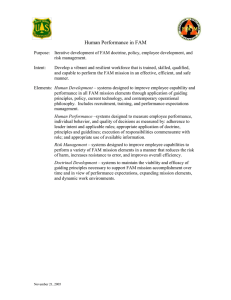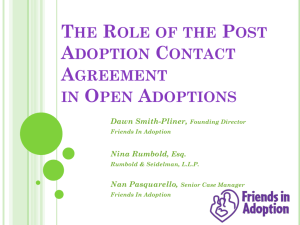A For est of Fa amily Tr rees - Tapestry Adoption & Foster Care Ministry
advertisement
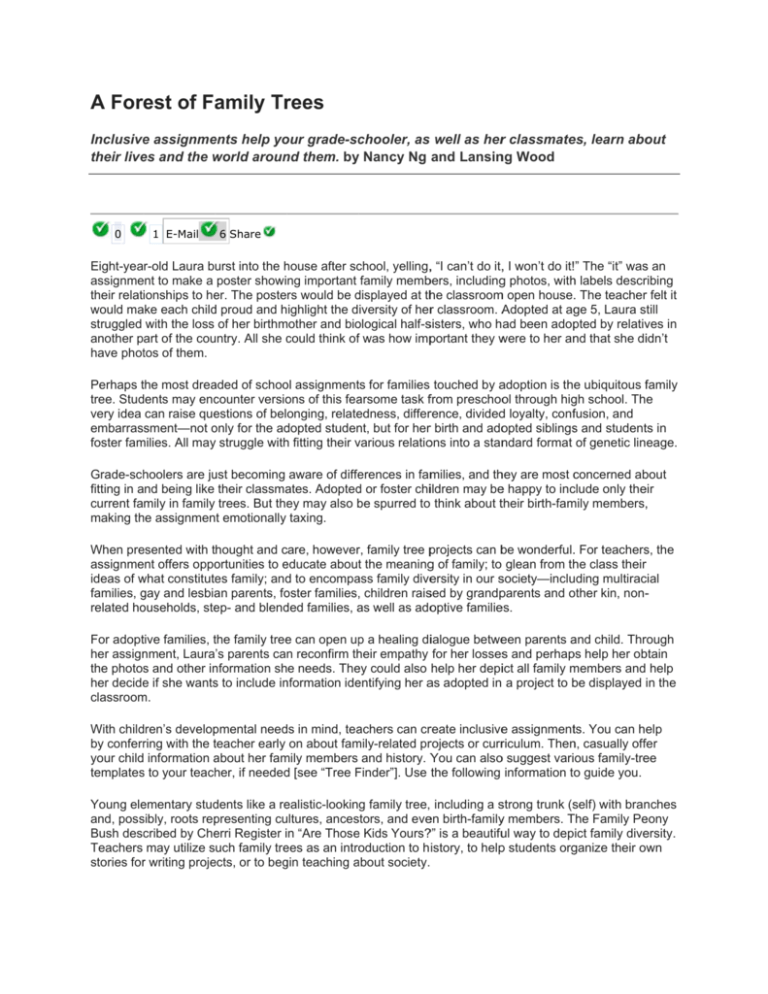
A Forest of Fa amily Trrees Inclusive e assignme ents help yo our grade-sc chooler, as well as herr classmate es, learn abo out their live es and the world w aroun nd them. by y Nancy Ng and Lansin ng Wood 0 1 E-Mail 6 Share Eight-year-old Laura burst into the house h after sc chool, yelling,, “I can’t do it,, I won’t do it!” The “it” wass an assignme ent to make a poster showing important family memb bers, including g photos, with h labels descrribing their relationships to he er. The posters would be displayed d at th he classroom m open house.. The teacherr felt it ake each child d proud and highlight the diversity of herr classroom. A Adopted at ag ge 5, Laura still would ma struggled with the loss of her birthm mother and bio ological half-ssisters, who had been adop pted by relativves in another part of the cou untry. All she could c think off was how imp portant they w were to her an nd that she diidn’t have phottos of them. Perhaps the t most drea aded of schoo ol assignmentts for families touched by a adoption is the ubiquitous ffamily tree. Stud dents may enc counter versio ons of this fea arsome task ffrom preschoo ol through hig gh school. The very idea can raise que estions of belonging, relate edness, differrence, divided d loyalty, conffusion, and embarrassment—not only o for the ad dopted studen nt, but for herr birth and ado opted siblingss and studentts in foster fam milies. All may y struggle with h fitting their various v relatio ons into a stan ndard format of genetic lineage. Grade-sch hoolers are ju ust becoming aware of diffe erences in fam milies, and th hey are most cconcerned ab bout fitting in and being like their classma ates. Adopted d or foster chiildren may be e happy to incclude only the eir current family in family trees. But the ey may also be b spurred to think about ttheir birth-fam mily members,, making th he assignment emotionally taxing. When pre esented with thought and care, c howeverr, family tree p projects can b be wonderful.. For teacherss, the assignme ent offers oppo ortunities to educate e aboutt the meaning g of family; to glean from th he class theirr ideas of what w constitute es family; and d to encompa ass family dive ersity in our ssociety—inclu uding multiraccial families, gay g and lesbia an parents, fo oster families,, children raissed by grandp parents and o other kin, non-related ho ouseholds, ste ep- and blend ded families, as a well as ado optive familie es. For adopttive families, the t family tree e can open up p a healing diialogue betwe een parents a and child. Thrrough her assign nment, Laura’s parents can reconfirm th heir empathy for her lossess and perhap ps help her ob btain the photos s and other in nformation she needs. The ey could also help her depiict all family m members and help her decide e if she wants s to include in nformation ide entifying her a as adopted in a project to b be displayed in the classroom m. With child dren’s develop pmental need ds in mind, tea achers can crreate inclusive e assignmentts. You can help by conferrring with the teacher t early on about fam mily-related prrojects or currriculum. Then n, casually offfer your child information about a her fam mily members and history. Y You can also o suggest various family-tre ee templates s to your teach her, if needed d [see “Tree Finder”]. F Use the following information to o guide you. Young ele ementary stud dents like a re ealistic-looking family tree, including a sstrong trunk (sself) with bran nches and, poss sibly, roots rep presenting cu ultures, ances stors, and eve en birth-familyy members. T The Family Pe eony Bush desc cribed by Che erri Register in “Are Those e Kids Yours? ?” is a beautifu ul way to depict family dive ersity. Teachers may utilize such family tre ees as an intro oduction to h istory, to help p students org ganize their o own stories forr writing proje ects, or to beg gin teaching about a society. At age 6 most children view adoption as a sunny event. Their trees reflect one big happy family, perhaps including birth, foster, and adoptive parents and siblings. Parents and teachers should honor such perceptions and not correct for factual reality. One kind of assignment might be to draw all of the people who live with you, and then all the other family members you know of. Follow your child’s lead in helping her organize this depiction and, if her artwork is posted in the classroom, be ready to answer such questions as: “How come you have five sisters and two brothers in your picture? Don’t you have only one baby sister?” At age 7 kids can be easily embarrassed. They like to fit in and dread being put on the spot. Because they’re aware that adoption is not a universal experience, they sometimes do best with a simple response to the family tree assignment, such as using only the adoptive-family configuration on the tree or artwork, coupled with a private, in-depth discussion in the safety of home. At age 8 many girls and some boys have a dawning realization of the loss inherent in adoption. They are starting to make connections between past, present, and future, and are intrigued by their own histories. Many like the concrete assignment of a realistic-looking family tree, which captures this information. Yet, because they are not yet able to distinguish between family and public information, kids this age often need help with assignments that involve personal relationships. Prepare for such assignments by clarifying your child’s adoption information and discussing answers to intrusive questions. Let your child know she can decide what answers to give or not give. The family tree can be an excellent opportunity for adoptive families to demystify and normalize their family experience. Parents should not hesitate to approach teachers with relevant information about their family. When you offer your teacher simple, age-related information and suggestions, you smooth the way for your child and, indeed, all students. Teachers who are aware of the sensitivities of adoption-built families can make the family-tree experience truly educational for all. Lansing Wood and Nancy Ng are board members of FAIR (Families Adopting in Response, www.fairfamilies.org). Tree Finder Here’s where to look for specific examples of inclusive family trees: • • • • Adoption and the Schools, by Nancy Ng and Lansing Wood, a guide to help parents and teachers anticipate problematic assignments, communicate effectively, and support learning. Read our review at www.adoptivefamilies.com/books.php. Adoptive Families Together, site of a Massachusetts-based support organization that offers family treestyle templates in downloadable PDF format (go to AFT's site and scroll down to "Alternatives to the Traditional Family Tree Assignments"). Are Those Kids Yours? by Cheri Register (Free Press, 1990), covers a range of internationaladoption family issues, and includes the Family Peony Bush. Lucy’s Family Tree, by Karen Halvorsen Schreck (Harpswell Press, 2003). Read our review and/or purchase at www.adoptivefamilies.com/books.php.
